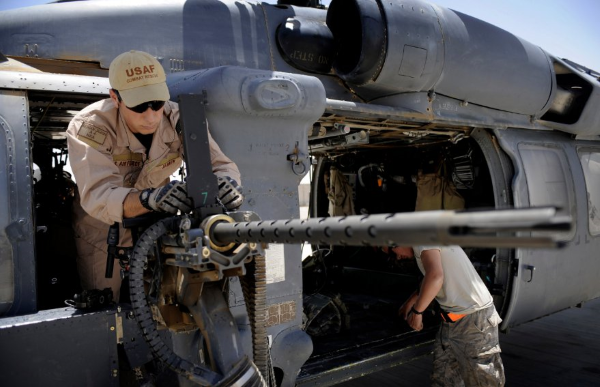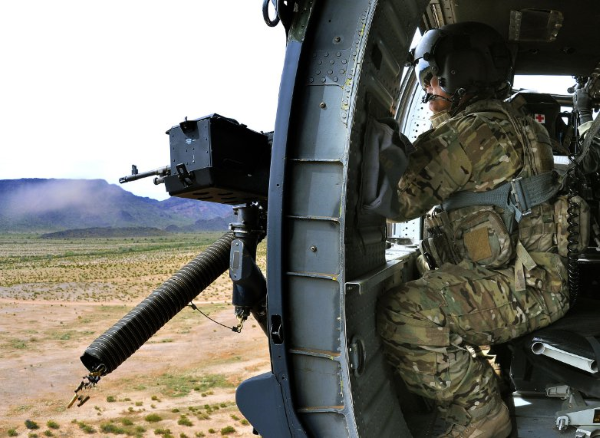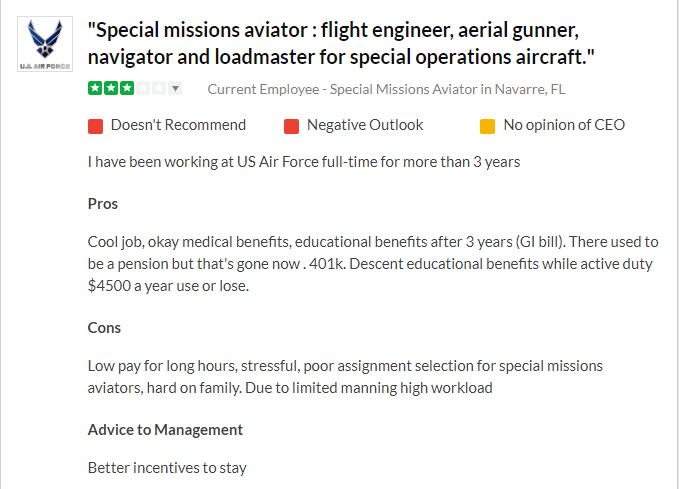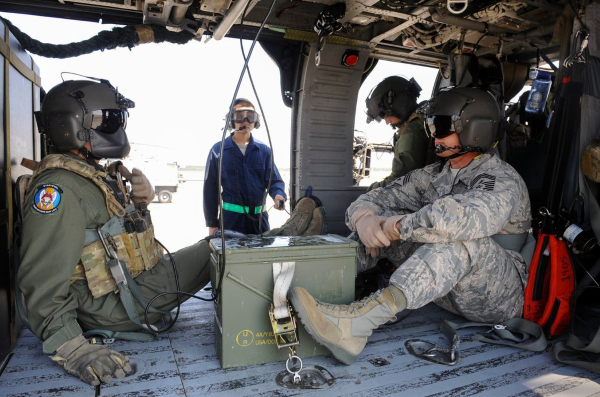Special Missions Aviator Quick Look
Here is an Air Force Specialty that can be exciting, demanding, and tense, all at the same time.
It’s a great Air Force career for those that want to be an integral part of an aircrew and are willing to be sent anyplace in the world at a moment’s notice.
Here are some of the duties that fall on the shoulders of a Special Missions Aviator:
- Performs pre-flight inspection of aircraft guns, defensive systems, cargo systems, airdrop equipment, and other related aircraft equipment according to proper flight manual procedures
- Maintains aircraft forms and records before, during, and after a flight has landed
- Has to be able to compute aircraft weight, balance, and fuel performance data manually and electronically
- Supervises cargo and passenger loading and off-loading on assigned aircraft
- Performs in-flight maintenance of airborne weapons systems and other associated mission support equipment
- Operates and monitors engine and other aircraft control systems to achieve maximum efficiency
- Assists pilots in such routine tasks as engine startups, in-flight operations, and engine shutdown
Many consider an Air Force Special Missions Aviator to be the jack-of-all-trades member of a flight crew.
That’s because they handle such duties as that of a loadmaster, aerial gunner, flight engineer, and navigator.
Related Article – Pros And Cons Of Joining The Air Force

For those that love a periodic adrenaline rush and have a stronger intestinal fortitude than most, being an Air Force Special Missions Aviator can end up being a very rewarding Air Force career choice.
Jump To A Section
Special Missions Aviation Requirements and Qualifications
Here are the prerequisite conditions that anyone who wants to enter into this Air Force career field must meet.
Educational Requirements
- High School Diploma or
- GED with 15 college credits
ASVAB Requirements
- Have a minimum ASVAB score of 60 in mechanical and 57 in the general category
Additional Qualifications
- Be between the ages of 17 and 39
- Height must be between 64 inches and 77 inches – no exceptions
- Have normal color vision and depth perception
- Be able to lift 70 lbs.
- Meet all other physical qualifications for aviation service
- Having a strong mechanical and electronics background is very desirable but not required
- Successful completion of 7.5 weeks of Air Force Basic Military Training held at Joint Base Lackland in San Antonio, TX (Not required of those with prior military experience or training)
- Must take the necessary steps to ensure their ability to mobilize and deploy anywhere in the world at a moment’s notice.
- Completion of a current Single Scope Background Investigation (SSBI) that leads to the ability of the Airman to obtain a Secret or higher-level security clearance
Once all of these conditions have been met, an Airman will then proceed to their next duty assignment to commence technical training.
Related Article – Air Force Aviation Resource Management (1C0X2): Career Profile
Training and Career Path to Become a Special Missions Aviator
Here is the training path it takes before someone can be called an Air Force Special Missions Aviator:
Air Force Technical Training Information
One does not have to go far after finishing Air Force basic training because the next school for becoming a Special Missions Aviator is held at the very same base.
That base is Joint Base Lackland in San Antonio, TX.
It is a short training period that lasts just under 1 month and covers just the basics of what this Air Force specialty entails.
Before the halfway point of technical training school, an airman should have been notified as to the location of their next duty station.
Once an airman completes technical training for this Air Force career field, they will receive college credits toward a Community College of the Air Force degree in Aviation Operations.
On-the-Job Training
Special Missions Aviator is another Air Force job that’s best learned by having hands-on experience as opposed to studying in a classroom setting.
That’s one of the reasons that the technical training school is so short.

Related Article – Air Force Airborne Cryptologic Linguist (1A8X1): Career Details
Just don’t make the mistake of thinking that a short tech school training period means there is not a lot to learn in order to become proficient in this Air Force job.
It is a demanding career field that requires an airman to learn not only their specific job but also the other support roles they have to play as an important part of the aircrew.
That’s why there will be an extensive and intense period of on-the-job training before a person can carry out the duties of a Special Missions Aviator on their own.
There is also a good possibility that an airman will cross-train to learn the support roles they will play on different types of aircraft.
There are several aircraft that are used to carry out the missions that Special Missions Aviators do.
These include:
- AC-130 Gunships
- CV-22 Osprey
- HH-60 Pave Hawk
- UH-1 Iroquois
- And more
Some of these aircraft have tactical roles to play in actual combat operations while others play a support role in both tactical and covert missions.
Aircrew Training
All enlisted Air Force personnel that work in positions that require flying must participate in several aircrew training courses before being allowed to fly.
These courses consist of:
-
Enlisted Aircrew Undergraduate Course
This course is undertaken at Lackland AFB in San Antonio, TX and lasts just over 2 weeks.
-
Combat Survival Training Course (aka SERE)
This is a 19-day course held at Fairchild AFB near Spokane, Washington.
-
Water Survival-Parachuting Course
Also conducted at Fairchild AFB, WA, the course is approximately 2 days long.
Related Article – Air Force Airfield Management Specialist (1C7X1): Career Details
How Much Are Special Missions Aviators Paid?
As far as take-home pay goes, there is no difference between the base pay a Special Missions Aviator gets paid and what another Air Force member of the same rank earns.
All Air Force and other military personnel are paid according to the guidelines set down by US Government lawmaking bodies.
Generally, however, they receive Aviation Incentive Pay (flight pay) on a monthly bonus.
An enlisted member going into the Air Force to become a Special Missions Aviator will most likely end up with a rank somewhere between an Airman Basic (E-1) to Airman First Class (E-3).
The higher ranks of Airman (E-2) or Airman First Class (E-3) are given out to those who have relevant schooling or work experience in the Special Missions Aviation field.
An individual’s recruiter will be able to give them a better idea of what rank they will begin their Air Force career at.
Related Article: Air Force Ranks And Pay
The 2023 pay scale for enlisted members with less than two years of prior military experience is currently as follows:
Airman Basic (E-1): $1,917.60/Month (after four months)
Airman (E-2): $2,149.20/Month
Airman First Class (E-3): $2,259.90/Month
And here’s a full pay chart for the Air Force enlisted personnel:
| Insignia | Pay Grade | Rank | Abbreviation | 2023 Minimum Monthly Pay |
|---|---|---|---|---|
| E-1 +4 months | Airman Basic | AB | $1,917.60 | |
| E-2 | Airman | Amn | $2,149.20 | |
| E-3 | Airman First Class | A1C | $2,259.90 | |
| E-4 | Senior Airman | SrA | $2,503.50 | |
| E-5 | Staff Sergeant | SSgt | $2,730.30 | |
| E-6 | Technical Sergeant | TSgt | $2,980.50 | |
| E-7 | Master Sergeant | MSgt | $3,445.80 | |
| E-8 | Senior Master Sergeant | SMSgt | $4,957.20 | |
| E-9 | Chief Master Sergeant | CMSgt | $6,055.50 | |
| E-9 | Command Chief Master Sergeant | CCM | $6,055.50 | |
| E-9 | Chief Master Sergeant Of The Air Force | CMSAF | $6,055.50 |
As was mentioned, this is just current take-home pay each month.
Advancement through the enlisted ranks is simply done by time in grade.
As an airman progresses toward the non-commissioned officer ranks, advancing to the next highest enlisted sergeant rank (E-4 to E-9) becomes more difficult.
That’s because it not only considers time in grade and service but there is also an Air Force knowledge test involved.
The more time in grade an enlisted member has, the lower the test score they will need to achieve the next highest sergeant rank.
There are also special promotions that are given to the best of the best in the Air Force enlisted ranks.
Miscellaneous Pay and Incentives
There is some opportunity for a good amount of miscellaneous pay that comes with being an Air Force Special Missions Aviator.
This list includes:
- Housing allowance for those that live off base (BAH)
- Subsistence allowance for those that eat off base (BAS)
- Temporary duty pay
- Hazardous duty pay
- Flight pay
- Cost of living adjustments
Of course, all of the necessary health care that any enlisted member needs is 100% paid for with no out-of-pocket expense in the majority of cases.
Note that many of your allowances aren’t subject to federal income tax. These include housing and subsistence allowances, clothing allowance, and family separation pay. This can add up to quite a bit over the year.
However, should you find yourself joining the USAF as a Special Missions Aviator, you should consult your tax preparer, as tax laws can change rather frequently.
What’s Life Like as a Special Missions Aviator?
This is a relatively new career field in the Air Force.
This Air Force AFAC was first created and implemented in 2012.
It became a combination of three different Air Force jobs; these were special operations flight engineer, aerial gunner, and loadmaster positions.
The change came about to give an airman acting in this capacity in the Air Force a more robust aircrew experience that now features less downtime.
It also allows airmen to be integrated into a mission from takeoff to landing.
When one assumes the role of a Special Missions Aviator, they will enjoy an exciting career that is fast-paced and challenging.
Contrary to popular belief, Air Force Special Missions Aviators rarely if ever leave their assigned aircraft during a mission.
That job is left up to members of Air Force Special Forces units such as those in Pararescue (PJ).
What being a Special Missions Aviator does not allow most of the time is for an Airman to have a routine lifestyle.
Someone working as a Special Missions Aviator can expect constant readiness training, an abundance of flight time, and will most likely experience frequent temporary duty travel too.
Not to mention, that someone in this career specialty can be summoned to any crisis area in the world at a moment’s notice.
If you have a family and more specifically children to help raise, you may strongly want to consider choosing a different Air Force career path.
There will still be periods of time when stationed on larger bases that a Special Missions Aviator can get accustomed to doing more routine activities.
They will be able to enjoy some of the privileges that go with being in the military during peacetime.
These include:
- The opportunity to participate in based sponsored sports and recreation
- The ability to take advantage of reduced prices on base shopping facilities
- Use of the gyms, sports courts, bowling, swimming and golf facilities that exist on many large Air Force Installations
- Weekly days off and 30-days leave with pay each year
Enlisted personnel are allowed to attend college courses in their off time in pursuit of a college degree; this would be difficult to do as a Special Missions Aviator because of the frequency that they move around.
Special Missions Aviator Job Reviews
Most people who have served or are currently employed in the Air Force as Special Missions Aviators have positive things to say about this career selection despite the demands it presents.
Here is what a current Air Force Special Missions Aviator had to say about his experiences on glassdoor.com:

There have also been those who have posted YouTube videos about what they do when serving in this capacity in the US Air Force.
Here’s one which follows Special Missions Aviators assigned to the C-130:
And here’s another one, featuring TSgt Justin Martin:
Special Missions Aviation Civilian Career Opportunities
This is not one of those Air Force jobs that people go into to get training and experience for an equivalent civilian job.
That’s because there is not a big need for Special Missions Aviators in the civilian job market.
It does not mean, however, that these jobs are non-existent in the civilian world.
There are also companies that need employees that use some aspects of what one learns from being a Special Missions Aviator.
Here are some samples of government and private employers that can use all or some of the skills that Special Missions Aviators learn from their time spent doing this job in the Air Force:
- Air Force/Air Force Reserve (for training purposes in most cases)
- Northrop Grumman
- Lockheed Martin Corporation
- Leidos
- UPS
- FedEx
- DHL
- Various Domestic Airline Carriers and support services (Loading and Refueling)
The starting pay for these jobs varies but should be in the $45,000 – $80,000 per year range.
In addition, there are several private military contractors around the world that operate aircraft similar to those used in Air Force Special Operations missions that hire former Special Missions Aviators.
Related Article: 9 Common Private Military Contractor Jobs (and 3 uncommon ones)
The largest of these include:
- G4S Global
- Xe Company (formerly known as Blackwater)
- Triple Canopy, Inc.
These jobs are most likely performed in hostile areas and they can be very lucrative because of that.
References:
Official Air Force Recruiting Page
Confidence gained through SERE combat survival training
- 5 Worst Jobs in the Air Force - June 20, 2024
- 4 Steps For Visiting An Air Force Recruiter Near You - June 19, 2024
- Air Force Safety Specialist (1S0X1) - June 19, 2024
General FAQ
What is a Special Missions Aviator in the Air Force?
The Special Missions Aviator position is a new specialty, created in 2012, and combines the duties of a flight engineer, loadmaster, and aerial gunner.
How much do Special Missions Aviator specialists get paid?
USAF personnel are paid according to rank and time in service, so a new airman with less than two years in service can currently expect a base pay of about $1,900 a month base pay after training. They may qualify for Aviation Incentive Pay and other allowances.
How long is training for Special Missions Aviator?
Tech school for USAF Special Missions Aviators is just under a month and is conducted at Joint Base Lackland, Texas. There are
How do you qualify for Special Missions Aviator?
To qualify as a Special Missions Aviator, you’ll need to be between 64 and 77 inches tall, have normal color vision, lift 70 pounds, and pass a background check leading to a Secret level security clearance.
Do Special Missions Aviator Specialists go through SERE?
Special Missions Aviators are required to take SERE — combat survival training — which must be kept current with regular training. They must also take water survival/parachute training periodically.
Originally posted on July 20, 2019 @ 5:38 pm
Affiliate Disclosure: This post may contain affiliate links. If you click and purchase, I may receive a small commission at no extra cost to you. I only recommend products I have personally vetted. Learn more.
